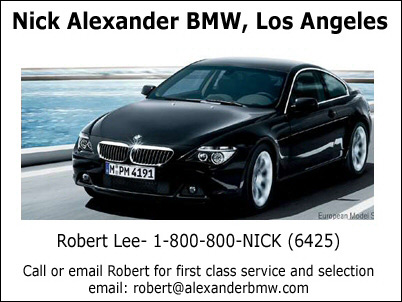
Overview
The introduction of the third generation BMW 5 Series Touring continues the bloodline of BMW’s famous Touring name that, since its debut, has stood for dynamism, practicality and style. Meeting the demands of the executive requiring dynamic on-road agility and large load carrying ability, the new model adds a refined, stylish look and a host of innovative technologies, ensuring that the Touring really is the estate car of choice.
First sold in the UK in 1991, the BMW 5 Series Touring defined the premium estate segment and a host of innovations offered on the new version set it apart from its rivals. Not only can this all-new Touring model come with Dynamic Drive and Active Steering, two features that hone ride and handling, but the first ever Head-up Display system offered on a BMW in the UK will debut in the autumn. Run-flat tyres also feature as does a Panoramic roof for open-air motoring.
On sale in May 2004, prices start from £29,415 for the BMW 525i SE Touring. In August 2004 the four models currently on sale, 525i SE Touring, 545i SE Touring, 525d SE Touring and 530d SE Touring, will be joined by the 535d SE Touring, with its twin-turbocharged diesel engine. In spring 2005 two further petrol-engined cars will complete the range – the 520i SE Touring and the 530i SE Touring.
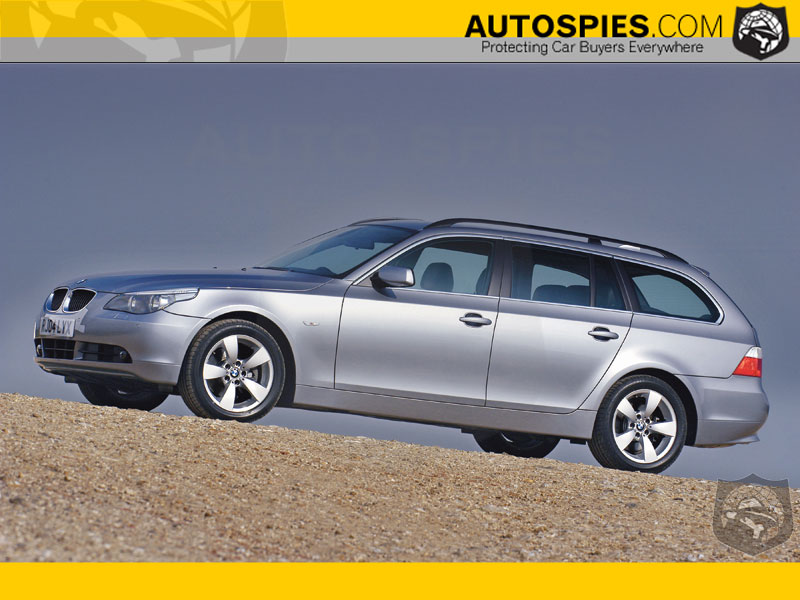
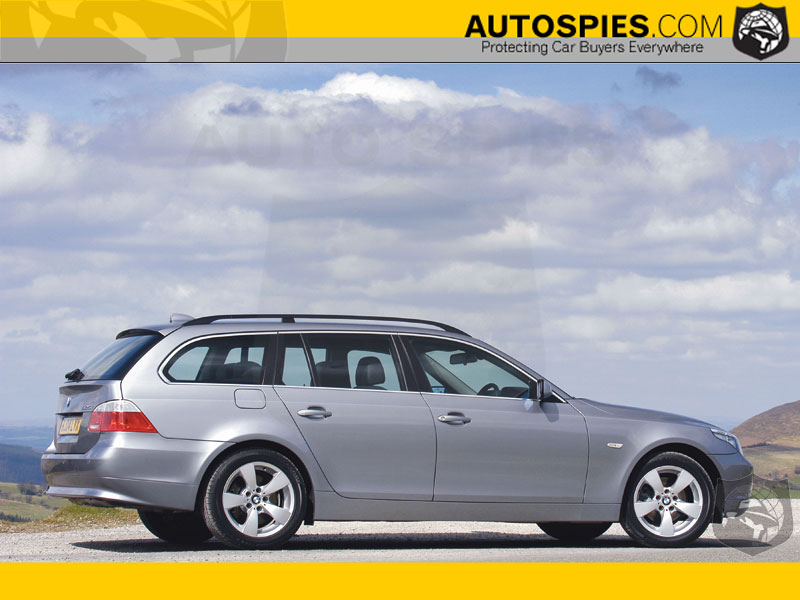
Highlights
• Wider, longer and taller than previous generation 5 Series Touring
• Choice of 2.5-litre and 4.4-litre petrol engines along with 2.5-litre and 3.0-litre diesel units
• Three gearboxes offered - six-speed manual is standard with six-speed Sequential Manual Gearbox and six-speed automatic available
• Up to 1,650 litres of load space with secure lockable storage area
• Split opening tailgate
• All aluminium front structure saving 50kgs of weight over previous model
• Self-levelling rear air suspension
• Cruise Control
• Run-flat tyre technology on cars with 17 inch and 18 inch alloy wheels
• Tyre Puncture Warning System
• Dynamic Stability Control and Dynamic Traction Control
• ‘Intelligent’ driver and passenger front and side airbags, plus head airbags for all
• ISOFIX child seat attachments
• Head-up Display offered for the first time on a BMW in the UK (autumn 2004)
• Panoramic roof (optional)
Model | Price OTR | Power bhp | Torque Nm | 0 – 62mph secs | Top Speed mph | Combined Mpg | CO2 g/km |
BMW 525i SE Touring | £29,415.00 | 192 | 245 | 8.2 | 145 | 28.5 | 238 |
BMW 525d SE Touring | £30,110.00 | 177 | 400 | 8.3 | 140 | 40.4 | 187 |
BMW 530d SE Touring | £33,930.00 | 218 | 500 | 7.2 | 151 | 39.2 | 192 |
BMW 545i SE Touring | £43,945.00 | 333 | 450 | 5.9 | 155 | 25.0 | 274 |
Design
The sleek, muscular lines of the 5 Series Touring shroud a car capable of conveying five adults and a vast amount of luggage in comfort and speed. With the 60:40 split rear seats folded forwards a 1,650-litre boot space beckons. With the seats in place and five people onboard, there is still 500-litres of boot space – an increase of 18 per cent over the previous Touring. Under the load bay’s floor a lockable secure storage is also a standard feature on all models.
For added practicality the rear tailgate splits so those loading smaller items can do so with the rear windscreen open while larger items can be easily accommodated by opening the main tailgate. Roof rails are a standard feature on all 5 Series Tourings and they not only improve the aesthetics of the car, but can accommodate a range of optional equipment such as bike racks and luggage boxes.
Measuring 4,843mm in length and with vehicle width increasing by 46mm to 1,846mm, the new 5 Series Touring boasts class-leading space for up top five people. While flat weave cloth seating is standard, buyers can also choose from three different grades of leather in addition to the three different seat shapes - standard, sports and comfort style.
Steering wheel mounted controls, including standard Cruise Control and BMW’s now familiar iDrive controller and display, ensures easy every day operation of all functionality .
Drivetrain
BMW is renowned for its smooth and powerful engines and the 5 Series Touring comes with four engines from launch. The 2.5-litre straight-six cylinder powerplant delivers 192bhp and a zero to 62mph time of 8.2 seconds along with a 145mph top speed and 28.5mpg figure. Representing the pinnacle of performance in the range, the 333bhp 4.4-litre in the BMW 545i SE Touring is capable of a 155mph top speed and a zero to 62mph time of 5.9 seconds while still achieving 25mpg.
For those wishing to focus on diesel power, two of BMW’s EU4 compliant diesel engines are offered. The 525d SE Touring has a 2.5-litre 177bhp engine capable of 40.4mpg but also a zero to 62mph time of 8.3 seconds and 140mph top speed. Meanwhile, the larger capacity BMW 530d SE Touring has a 3.0-litre 218bhp engine boasting a 39.2mpg consumption figure, but also a zero to 62mph time of 7.2 seconds and a top speed of 151mph.
Chassis and Suspension
Like its saloon counterpart, the extensive use of aluminium combined with a host of innovative technical features ensures the latest BMW 5 Series Touring is the most involving driver’s car in its segment. A sporty spring and damper set-up at the front has been combined with a self-levelling air suspension for the rear. Designed to act almost horizontally, the air suspension units do not intrude into the boot area like conventional suspension turrets and so create the maximum width available. An air compressor also maintains the optimum rear ride height given any load.
Meanwhile, the two optional features of Dynamic Drive and Active Steering have taken estate car ride and handling to another level. Dynamic Drive uses hydraulically controlled anti-roll bars to counteract body sway in corners and eliminate the vibrations a poor road surface produces. At up to 0.6g of lateral force, far more than experienced on a fast twisting lane, the body only rolls 0.5 degrees. A conventional, non-Dynamic Drive car would experience this at just 0.1g of lateral force.
Active Steering on the other hand, uses an electric motor and separate transmission on the steering column to vary the steering ratio depending on road speed. At slow speeds and when parking only 1.7 turns are required to go from lock to lock, but at higher speeds a nominal three turns are needed to perform the same procedure. To qualify this, as no one will turn from lock to lock at high speeds, this change of steering ratio equates to a less sensitive feel and subsequent response, making the car feel more composed when at pace.
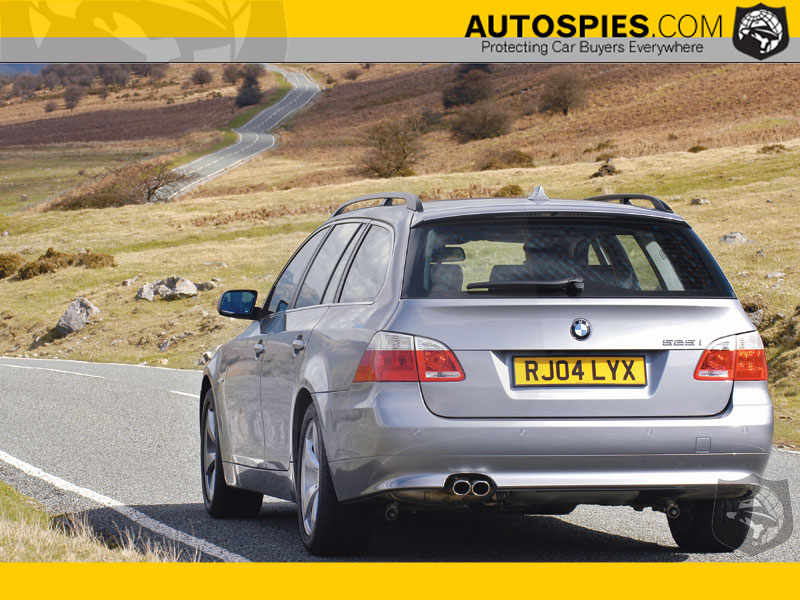
Safety
With an exceptionally rigid safety cell, six airbags as standard and seatbelt pre-tensioners, the occupants of a BMW benefit from superb levels of protection available. What’s more, all BMW 5 Series Tourings come with Dynamic Stability Control and Dynamic Traction Control, Anti-lock Braking System, Dynamic Brake Control and Tyre Puncture Warning System. Brake Force Display - BMW’s variable brake light intensity system that increases illumination in the event of an emergency stop or if the ABS is activated - also now features to warn drivers behind of a possible incident ahead.
Technology
BMW’s history of developing innovative but usable driver focussed technology continues with the latest Touring. From autumn 2004 Head-up Display (HUD) offers a system that projects speed, navigation instructions and check control messages onto the windscreen in the driver’s line of sight. Research has proven HUD cuts reaction times and the onset of driver fatigue.
The 5 Series Touring can also come with a Panoramic Sunroof, Active Cruise Control, (a system that uses a radar operated cruise control to maintain a safe distance from the car in front), and Adaptive Headlights. Using speed and direction signals the headlight beams swivel by up to 15 per cent in corners, increasing illumination at night by up to 90 per cent. Park Distance Control and improved levels of satellite navigation systems also feature.
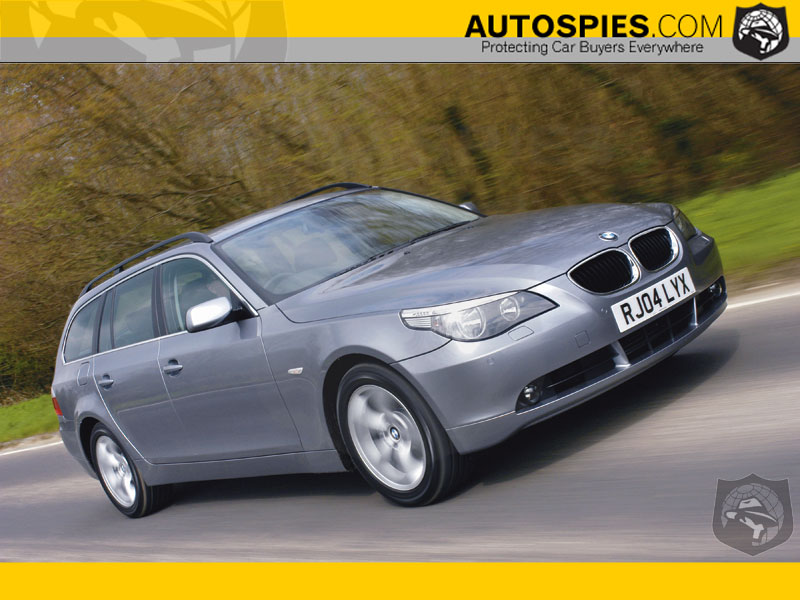
Market
The E34 BMW 5 Series Touring proved a popular choice in the UK selling 8,926 cars between 1991 to 1996. The E39 that followed was even more successful, nearly doubling this figure between 1997 and 2003. The new model is expected to surpass this tally with sales in excess of 2,500 in a full year of production. The average 5 Series Touring buyer will be a family man aged between 40 to 50 years-old.
Summary
Larger, lighter, more versatile than before and with more performance, better economy and EU4 emission-beating diesels, the 5 Series Touring carries on where the successful E39 Touring left off. As the driver’s choice for an executive car that offers additional space it is the perfect complement with BMW’s range of load carrying cars. With the arrival of the 5 Series Touring and with the X3 in the same month, BMW now offers dynamic, practical cars that cater to virtually all requirements.
History
Introduced onto the world stage in 1971, BMW’s first Touring models heralded a new age of estate cars.
By combining sports car handling with a large carrying capacity, the BMW 02 Series was a world away from the ungainly and cumbersome shooting brakes offered by other manufacturers at the time. The most powerful ver¬sion, the 130bhp BMW 2002tii Touring, had a top speed of 118mph and ranked among the best performers in the market at the time. Even though this was the launch of an important new motoring concept sales were modest with 31,000 sold during four years of production. Perhaps this unusual car was too far ahead of its time?
Development of the Touring concept then came to rest for nearly 15 years, until the first BMW 3 Series Touring entered the market in 1988. The time was now right for a car combining sporting performance and elegance with versatility. Sales of the first generation 3 Series Touring up to 1995 totalled 105,000 units worldwide. This sales success indicated the desirability of BMW’s Touring versions of its sporting saloons, encouraging the company to introduce the first 5 Series Touring in 1991.
The BMW 5 Series Touring was one of the first estate cars in the upper mid-¬range segment and, like the 3 Series Touring before, was perfectly timed. From 1991 to 1996 the segment grew by 25 per cent and the 5 Series Touring was responsible for a large part of that growth, accounting for 55 per cent of the global market.
Proving its merits in the market as a four, six or eight-cylinder petrol engine and a six-cylinder diesel, with engine out¬put ranging from 113bhp to 286bhp, owners could also opt for a four-wheel-drive version in the BMW 525iX.
BMW pioneered the use of dual fuels in the segment when launching the 518g, a car which could run on both petrol and natural gas. This dual-mode Touring, presented at the 1995 Frankfurt Motor Show, only remained in production for European markets for one year and never came to the UK. A lack of a network of natu¬ral gas filling stations thwarted the econom¬ic success this groundbreaking model deserved.
Sales of the first-generation BMW 5 Series Touring amounted to 125,700 units worldwide and after 8,926 5 Series Touring sales in the UK, the second-generation E39 5 Series Touring entered the market in 1997. Featuring the then revolutionary aluminium suspension of the 5 Series saloon, the Touring immediately outclassed the competition. Body stiffness increased by 50 per cent leading to a more involving and rewarding driving experience. Thus, the spring struts were engineered to fit almost horizontally so as not to intrude into the capacious boot. This increased width in the rear luggage compartment by a remarkable 16 centimetres, making for a flatter and wider load area.
During its seven years of production, the second-generation BMW 5 Series Touring featured a total of 10 different engines in a power range from 136bhp to 286bhp – four of these powerplants being die¬sels. Sales figures also exceeded all expectations, with nearly 16,000 cars sold to customers in the UK and 270,000 being sold worldwide. These figures were more than twice the number of the first-generation model.
Once again, the time is right for the new generation 5 Series Touring to enter the marketplace. The new car, being larger, faster, more economical and practical is destined to build on the success of the previous model.
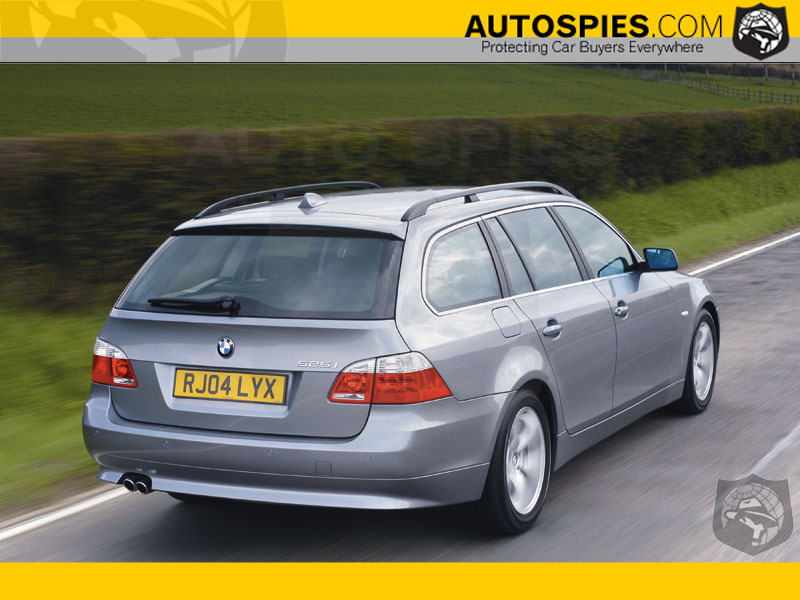
Market
| Price |
BMW 525i SE Touring| £29,415 |
| BMW 525d SE Touring | £30,110 |
| BMW 530d SE Touring | £33,930 |
| BMW 545i SE Touring | £43,945 |
The all-new BMW 5 Series Touring, with its muscular lines, impressive performance and increased carrying capacity and flexibility will appeal to many. Like previous Touring models the average buyer is likely to be between 40 to 50 years of age, successful in their chosen career and regularly participate in active leisure pursuits. More than 90 per cent will be married and most will have a family. But, while the owner profile seems oriented towards the family buyer, there is a growing market for new customers in this segment looking to benefit from the car’s practicality, lifestyle and performance attributes – in essence, buying into the Touring brand.
Running costs look set to be kept to a minimum, thanks not only to BMW’s Service Inclusive offer, but also the car’s insurance ratings. A BMW 525i SE Touring and the BMW 525d SE Touring have been given a 16E rating, while the 530d SE Touring has a 17E rating. The flagship model, the 545i SE Touring, has a 18a grade.
Following the car’s May launch, BMW expects to sell approximately 1,900 cars in 2004, with more than 2,500 sales in a full year. To put this into historical perspective, the best ever sales year for the previous E39 Touring matched this figure. The arrival of the BMW 535d SE Touring later this year and the BMW 520i SE Touring and BMW 530i SE Touring in 2005 are expected to boost 5 Series Touring sales to record levels in the UK.
2003 BMW 5 Series Touring sales
| Model | Sales | Percentage |
| 520i | 194 | 9 |
| 525i | 262 | 12 |
| 525d | 803 | 38 |
| 530i | 224 | 10 |
| 530d | 645 | 30 |
| 540i | 14 | 1
| Total | 2,142 | 100 |
Sales history – BMW 5 Series Touring
| Production | Worldwide | UK Sales |
| E34 | 1991-1996 | 125,700 | 8,926 |
| E39 | 1997-2003 | 266,209 | 15,530 |
The arrival of the 5 Series Touring and new X3 models means BMW now offers four cars that combine extra practicality with the sporting performance expected of its saloon cars. The X3 and X5 cater for those who require an all-wheel-drive car, while the 3 and the 5 Series Touring models appeal to customers with an active lifestyle and a self-image that coverts the estate version over the saloon.
Jim O’Donnell, managing director of BMW (GB) Ltd, said: “BMW has traditionally excelled in this market. The 5 Series accounts for nearly 15 per cent of BMW’s sales but its impact as a product punches way above this statistic. In winning What Car? Executive Car of the Year in 2004, the latest BMW 5 Series Saloon has proved it’s still the car of choice and we expect the same to be the case for the Touring.”
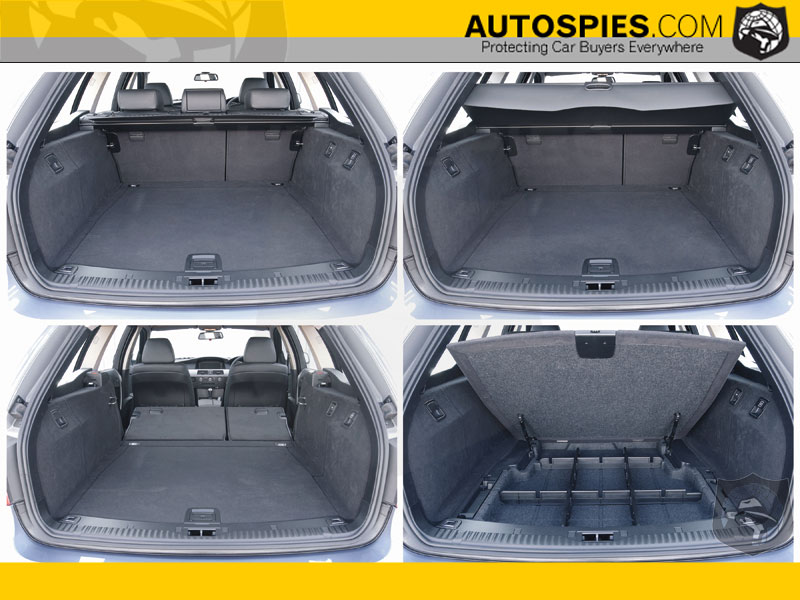
Design
It is rare that an estate model commands the same visual appeal as its saloon variant, but it is a feat BMW’s design team has again managed to achieve with the all-new 5 Series Touring. From the muscular sculptured front, to the chiselled sides and curved rear roof, the visually striking lines prove you can make a practical car stylish. Wider, longer and taller than the previous 5 Series Touring, the new car offers greater space, comfort, practicality and flexibility than its forebear. The elegant and practical interior is wrapped in a body that makes dramatic use of concave and convex surfaces clearly emphasizing the car’s dynamics. The wider track and scalloped wheel arches add to its understated but sporty stance, as does the way the tailgate stretches around the D-pillars.
Increased dimensions
With its increased dimensions, the new 5 Series Touring offers greater practicality and use of space. The wheelbase has been extended by 59mm to 2,886mm and an overall length of 4,843mm means there is ample legroom for five adults. With vehicle width increasing by 46mm to 1,846mm, class-leading shoulder room is available to all occupants. Despite the curved roofline, the car’s headroom has actually been increased by 23mm – the highest point of the 5 Series now standing 1,491mm tall.
Increased load carrying capacity
Sheer dimensions aside, the 5 Series Touring offers a capacious 1,650 litres of luggage with the rear seats folded. With them in place, 500 litres of boot space beckons – an 18 per cent increase on the previous model. Split folding rear seats, with a 60:40 split ratio, add extra practicality. When folded, the rear seat back sits on the base offering a nearly flat luggage compartment with a one-touch operation. The dimensions of the boot measure 1,110mm wide, 787mm high and a maximum depth of 1,880mm and the Touring is capable of transporting a weighty 600kgs payload. Access for loading large items is via the main tailgate or smaller items can be easily stowed by lifting the rear windscreen.
Secure under floor storage
Extra security is offered in the boot with a lockable under floor storage area. On opening the latch, two dampers push the boot floor cover open, holding it in place to reveal an under floor storage box. A Storage Compartment Package option can also be specified, offering a number of combinations aimed principally at preventing large items sliding around while driving.
Additionally, should a 5 Series Touring be upgraded from the standard 16-inch wheels to the optional 17-inch Run-flat tyres, then another cargo area below the lockable storage compartment presents a further 35-litres of discreet space.
Automatic Tailgate
The final practical touch is the Automatic Tailgate option that lets the driver open and close the boot via the key, eliminating the need to unlock and open the boot when fully laden with bags. This is in addition to the split opening tailgate and automatic load cover release mechanism operated by the button located under the rear wiper arm spindle. This discreet button operates the catch allowing the load cover to retract on opening the tailgate for easier access. On wanting to close the boot, the owner just has to click this back in place.
Roof rails, which not only add to the aesthetics of the car but have been designed to take a range of accessories such as bike racks, luggage boxes or ski racks, are another standard feature.
Interior
Those familiar with the driving environment of the 5 Series Saloon will instantly recognise the cockpit of the Touring as a BMW. The dashboard features the same double wave binnacles housing the standard iDrive screen to the left with the speedometer and the rev counter positioned behind the steering wheel. By including the ground breaking iDrive controller there are fewer buttons and switches to clutter the dashboard making for a smooth, elegantly finished interior.
The drivers and passengers of the new BMW 5 Series Touring can get comfortable courtesy of a range of seats. Standard on all models is the durable flat weave fabric trim. Owners wanting to upgrade however, can choose the optional sports seats (standard on the 545i SE Touring) or comfort seats along with three differing grades of leather – Dakota, Nasca and Exclusive. In standard trim these seats are part-electrically adjustable, but, by specifying comfort seats, sees full electric seat adjustment combined with active head restraints fitted.
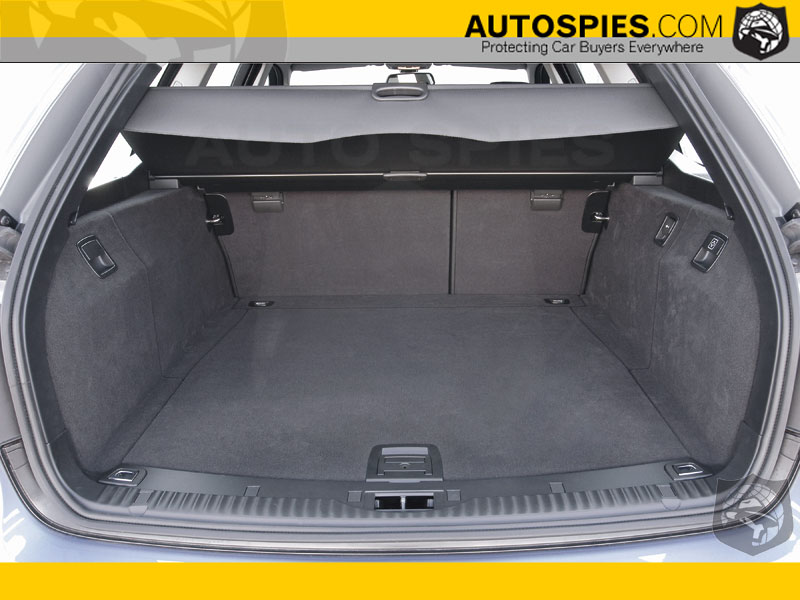
Drivetrain
As the largest single recipient of International Engine of the Year awards, BMW is understandably cited as producing some of the best engines in the world. From launch, the new 5 Series Touring features four engines including the range-topping and award winning 4.4-litre V8 unit.
BMW 525i SE Touring
As the entry-level car, the BMW 525i SE is powered by a silky smooth 2.5-litre straight-six petrol producing 192bhp. The car delivers a maximum torque figure of 245Nm at 3,500rpm and powers from zero to 62mph in 8.2 seconds (8.8 seconds for the automatic). However, even with performance that culminates in a 145mph top speed, fuel consumption remains competitively high at 28.5mpg (27.4mpg).
BMW 525d SE Touring
Powered by a straight-six cylinder diesel engine, featuring a Variable Nozzle Turbine turbocharger and the second-generation common rail fuel injection, this Euro IV compliant engine produces an impressive 177bhp. The 2,497cc unit also has a maximum torque of 400Nm, which is consistently maintained from 2,000rpm to 2,750rpm. Impressively 80 per cent of maximum torque is available from just 1,400rpm up to 3,800rpm. When compared to the previous Touring model, power is up by 14bhp and 50Nm.
The BMW 525d SE Touring makes for rapid transport, accelerating from zero to 62mph in 8.3 seconds (8.5 for the automatic) before going on to reach a 140mph (138mph) top speed. Fuel consumption figures are equally admirable with this model achieving a combined figure of 40.4mpg.
BMW 530d SE Touring
The 5 Series Touring range also features BMW’s acclaimed 3.0-litre diesel engine, already available in the 3 Series, 5 Series Saloon, X5 and 7 Series line-up. Badged BMW 530d SE, the 218bhp unit has a maximum torque value of 500Nm from just 2,000rpm, while zero to 62mph takes 7.2 seconds (7.4 seconds for the automatic). Top speed is 151mph, but the high performance figures haven’t impacted on economy and the 530d engine positively sips fuel, posting an average consumption figure of 39.2mpg (35.3mpg). Like its BMW 525d SE Touring stablemate, it is also Euro IV emission compliant thanks again to a maintenance free particulate filter.
Both diesel engines feature second-generation common rail technology, which has seen fuel chamber pressures increase from 1,350 to 1,600 bar over the previous 3.0d engines. The increase in pressure allows fuel vapour to be injected into the cylinders at up to four times per stroke, maximising economy and minimising emissions. Revised turbocharger blade geometry, allied to the use of lighter materials, also improves the efficiency of the turbo. In total, this combination of precise injection and maximum fuel combustion makes for a highly efficient, yet high performing, engine.
BMW 535d SE Touring (autumn 2004)
The BMW 530d SE will be the flagship diesel until this autumn when a new engine furnished with twin turbos joins the range in the BMW 535d SE Touring. Available exclusively with a six-speed automatic transmission, this engine will offer 272bhp and 560Nm of torque – the highest ever amount of diesel power in the executive estate segment. These momentous figures have been achieved thanks to the unique multi-stage turbocharging technology that sees air compressed by one turbine before being fed into a second. Under a maximum pressure of 2.85 bar the air then passes through an intercooler before finally entering the 3.0-litre engine. The result is extremely high boost pressure offering 89 per cent of maximum torque from a barely idling engine speed of just 1,500rpm.
This unique technology means the car will achieve a zero to 62mph time of 6.6 seconds. Its breadth of performance and reliability has already been proven in the Dakar Rally, the world’s toughest motor sport event. BMW supplied Belgium’s independent X-Raid Team with a twin turbo engine for use in each of its X5 Dakar Rally cars so the new powerplant could be proven to the extreme. The results were impressive with the X5 victorious on two stages, winning the diesel category outright and finishing 4th and 8th overall – not bad for an engine that still surpasses EU4 emission standards and features the most advanced particle filter technology.
BMW 545i SE Touring
Even with the arrival of the BMW 535d diesel, the range-topping Touring will still be the BMW 545i SE. Powered by the 4.4-litre V8, which was 2002 International Engine of the Year, this 333bhp all aluminium unit develops a maximum torque of 450Nm at 3,600rpm. Performance figures of zero to 62mph in 5.9 seconds rival many a sports car with the top speed electronically limited to 155mph. But with this awe-inspiring performance on tap, the 4,398cc engine still records an impressive combined consumption figure of 25.2mpg.
Bi-VANOS and VALVETRONIC technology
The outstanding performance of BMW’s six-cylinder and eight-cylinder engines have been hugely influenced by a host of technical innovations that have pushed the boundaries of modern day engine technology.
BMW’s bi-VANOS camshaft control system helps the engine breathe with optimum efficiency. It works by an adjustment mechanism powered by a hydraulic pump altering the position of the camshaft relative to the crankshaft. This mechanism controls the timing of when the inlet and outlet valves open on the engine, providing the optimum amount of fuel vapour to reach the combustion chamber with exhaust gases being removed with maximum efficiency.
Working in conjunction with bi-VANOS on the BMW 545i SE Touring is VALVETRONIC. First engineered for powerplants produced at BMW’s Hams Hall production facility near Warwick, England, this technology helps the car’s engine breathe more easily for optimum performance. It works when an electric motor controlled by the car’s Digital Motor Electronics control unit alters the extent the valves open, infinitely varying the amount of fuel vapour that is drawn into the engine.
DIVA
By adjusting the intake manifold length the performance characteristics of the engine can again be enhanced for optimum combustion. Alterations to the throttle and driving style dictate the required manifold length to obtain the most favourable air fuel mix before it reaches the combustion chamber.
Digital Motor Electronics
DME is a system that monitors and controls all vital engine functions such as ignition and fuel injection as well as numerous additional functions including lambda control – the device that checks an engine’s exhaust breathing performance by measuring the spent air fuel vapour mix. In this way DME ensures optimum power with low fuel consumption and cleaner emissions.
BMW prides itself on the reliability and longevity of its engines. The chain-driven camshaft as well as the ribbed V-belt ancillary drive units are all maintenance free and are designed to last the full life of the engine. Valve clearance need not be adjusted thanks to a self-adjusting hydraulic valve play system. The clutch is also another self-adjusting item, while the spark plugs and air filters only have to be changed every 62,000 miles. The transmission fluid in all gearboxes lasts the life of the unit. Finally, Condition Based Service (CBS) in the all-new BMW 5 Series Touring also means the oil change intervals can be as long as 20,000 miles, depending on driving style. CBS also notifies the driver of the need to replace any worn components as and when required, rather than replacing them prematurely and therefore unnecessarily.
Transmissions
Standard on the new BMW 5 Series Touring, the six-speed manual gearbox delivers a perfect balance of performance and economy. Engineers subtly altered the ratios on the gearbox resulting in a 15 per cent increase in engine performance transmitted to the road, while at the same time a four per cent fuel saving has also been achieved. To do this a shorter first gear provides greater initial thrust while a longer sixth reduces engine speed and cabin noise.
Drivers of petrol variants can also experience the benefit of BMW’s involvement in Formula One. The six-speed Sequential Manual Gearbox (SMG) gives the driver the full racetrack feel with gear changes made via a pair of paddles located behind the steering wheel. As the SMG system is an automated manual gearbox there is no clutch pedal and hydraulic actuators engage and disengage the clutch to shift gears – all within 150 milliseconds.
Another option for buyers is the six-speed automatic gearbox that offers the driver the chance of engaging a manual mode courtesy of the Steptronic function M/S. On shifting the gearstick to its M/S gate position the automatic gearbox changes to ‘Sport’ mode. The car is then primed for manual driving, with the driver having to either push forward on the gearstick to go down a gear or pull backwards to change up.
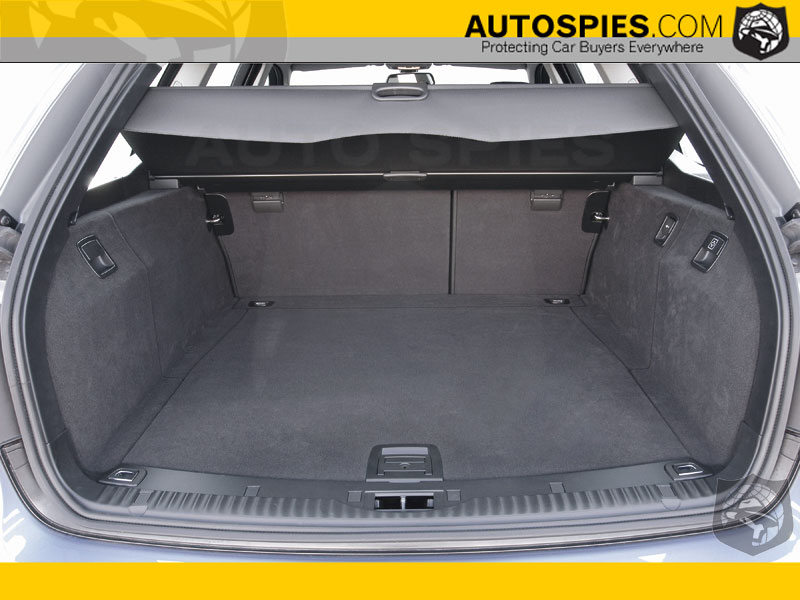
Chassis and suspension
BMW cars are renowned for their handling prowess, but even though the 5 Series Touring offers supreme levels of practicality, it was engineered to perform as well as any other sporting car in the range. The lightweight, all aluminium chassis, has reduced the overall weight by up to 50kg when compared to the previous generation, even with the addition of innovative features that offer an unprecedented driving experience for a premium estate car.
Like the 5 Series Saloon and the recently launched 6 Series Coupé and Convertible, the BMW 5 Series Touring is constructed with a hybrid mix of materials in a successful bid to keep weight to a minimum. The extensive use of aluminium, especially at the front of the car, has helped reduce the weight despite the latest 5 Series Touring growing in all dimensions.
Lightweight construction
The BMW 5 Series Touring features a particularly lean front end with every piece of body structure ahead of the A-pillar built from aluminium. The remainder of the car’s body uses high quality steel ensuring superior strength and rigidity. This hybrid use of steel and aluminium is considered beneficial to a wholly aluminium body because it meets BMW’s holy grail of 50:50 weight distribution.
But using aluminium was not without difficulty. Due to the differing chemical structures of aluminium and steel, welding the two together leads to corrosion. To overcome this, engineers developed a system by which the 5 Series Touring’s body parts are riveted and bonded together. This also contributes to increased body stiffness over a purely riveted body.
Other innovative features showcase BMW’s commitment to lightweight technological solutions. The optional six-speed automatic gearbox tips the scales at 8kgs less than the previous five-speed unit, while ultra-light acoustic sound deadening materials save a further 10kgs. In addition, the doors are 4.3kgs lighter and the front and rear windscreens weigh 1.3kgs less than the outgoing model.
The chassis and suspension of the 5 Series Touring is largely identical to the all-aluminium construction of its saloon equivalent. Aside from a few wearing components such as thrust rods, wheel bearings or pivot joints, the spring strut tiebar front axle is made entirely of aluminium. A U-shaped front axle subframe accommodates the steering rack, anti-roll bar, track control arms and tiebars, and is additionally reinforced by a thrust plate to ensure transverse stiffness and a more precise steering response. In all, the chassis of the 5 Series Touring comprises approximately 500 steel and aluminium components that weigh just 350kgs.
Self-levelling rear air suspension
A standard feature on all 5 Series Tourings, the self-levelling suspension uses a compact air spring and damper arrangement to create a large, flat load area for the boot. An air compressor that alters the ride height depending on load weight, also ensures whatever the size and weight of load, the car remains composed and stable irrespective of speed.
Sports suspension is available offering even more dynamic ride with stiffer dampers and more progressive springs. The rear air suspension is modified for a firmer ride, with the car’s overall ride height being lowered by 15mm.
Dynamic Drive
Debuted in the 7 Series, Dynamic Drive provides a combination previously thought impossible, namely a soft, comfortable ride with the handling of a sports car and lack of body sway or roll.
Dynamic Drive uses an intelligent electronic control system that monitors the suspension and damping of the car while controlling active anti-roll bars on the front and rear. Using a hydraulically operated swivel motor connected to one half of the anti-roll bar assembly, the active units convert hydraulic pressure into a torsional, stabilising force.
As a result, a car fitted with Dynamic Drive can corner completely level on a central plane up to 0.3g, equivalent to a fast trip on a winding country lane. If the driver pushes on and subjects the car to 0.6g of lateral acceleration, body roll still remains at an impressive 0.5 degrees. Beyond the 0.6g threshold the laws of physics do their best to unsettle the car, but the lean angle still only increases to 1.3 degrees. To put this in context, a non-Dynamic Drive vehicle fitted with conventional mechanical anti-roll bars starts to experience lateral body movement when cornering forces reach just 0.1g.
A further benefit of Dynamic Drive is that it requires less steering movement from the driver, with up to 15 per cent less input required when heavy cornering. The reason for this is simple, because the car is more composed in a bend, less steering input is required by the driver to make progress. Thus, a Dynamic Drive equipped car tackles winding roads without unsettling the passengers.
But Dynamic Drive can even be beneficial on straight roads. Normally, when a wheel rolls over a bump or sinks into a pot-hole, a conventional chassis transmits the resulting movement to the opposite wheel via the anti-roll bar, unsettling the car. Engineers refer to this effect as ‘copying’. However, a vehicle equipped with Dynamic Drive overcomes this by using the active anti-roll bars that work independently and are disconnected from one another by the swivel motor. This motor suppresses the effect an uneven surface could have on ride quality by counteracting any movement.
Active Steering
Dynamic Drive shows one significant way of improving a car’s handling. The same dramatic effect can also be made to the steering capabilities of the 5 Series Touring with Active Steering. A conventional steering set-up features a fixed ratio of 13.7:1 (i.e. turning the wheel by 13.7 degrees changes the angle of the front wheels by 1 degree) irrespective of speed. This makes for a compromise at all speeds that drivers have simply lived with for years. BMW’s new optional Active Steering eliminates this compromise and moves steering technology to a new level by making wheel inputs more direct at slow speeds on twisting roads, but more indirect and stable at higher speeds on straighter roads.
The system works by offering a fully variable steering ratio between 10:1 at standstill to 20:1 at higher speeds. This is made possible by incorporating an electric motor with an additional planetary gear transmission, with two input shafts located in a split in the steering column. One of these shafts is connected to the steering wheel, the second, powered by the motor and using the transmission, serves to impose an additional steering angle on the planetary gearing dependent on road speed. In the simplest terms, at low speeds the motor and transmission spins in the same direction as the input on the steering wheel, effectively tightening up the ratio and making the car turn in quicker. At higher speeds the reverse happens with the motor working against steering wheel input.
To illustrate the effect, when parking the driver of an Active Steering equipped car would have to turn the steering wheel 1.7 turns from lock to lock compared to the three turns a conventional car would take. Parking and slow speed manoeuvrability in towns is therefore quicker and easier. Importantly, the driver always has a mechanical connection with the wheels for ultimate feel and piece of mind. Should the system malfunction then the car would simply revert to non-Active Steering mode.
But it is not just the difference in steering ratio that sets Active Steering apart. There is one further inherent safety benefit because it is linked to Dynamic Stability Control (DSC) - Active Steering constantly calculates the optimum front wheel direction based on speed and yaw measurements taken 100 times a second as well as the driver’s input. This is then fed back into the DSC network to ensure the car is headed in the desired direction. When sudden unpredictable movements in a car’s direction induce or indicate oversteer, Active Steering counteracts the oversteer by altering wheel angle within milliseconds – much faster than a driver could react. In doing so, it effectively countersteers to stabilise the car without the driver even realising it. As a result DSC interruption is reduced under enthusiastic driving ensuring that even in a BMW 5 Series Touring safety concerns do not impact on driving enjoyment.